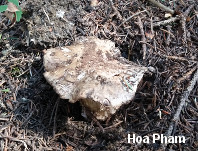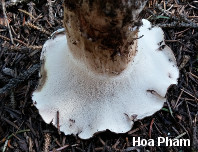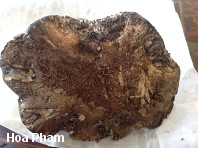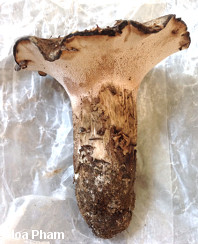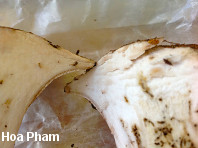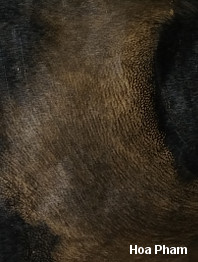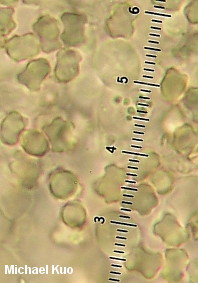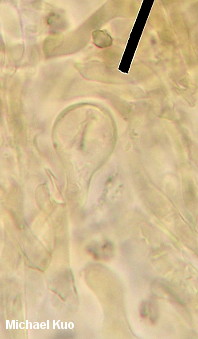| Major Groups > Polypores > Stemmed, Pale-Fleshed > Boletopsis leucomelaena |

|
Boletopsis leucomelaena [ Basidiomycota > Thelephorales > Bankeraceae > Boletopsis ... ] by Michael Kuo Boletopsis leucomelaena, like its cousin, Boletopsis grisea, is confusing. It looks like a tough-fleshed bolete--or, then again, maybe it looks like a soft-fleshed polypore. And now, DNA studies tell us it is closely related to toothed mushrooms like Sarcodon imbricatus. Add to this confusion the centuries-long debate about where the species lines should be drawn in Boletopsis and, well, you may not want to go there. If you're bound and determined, however, the first thing you will need to figure out in order to identify your Boletopsis is the kind of tree (spruce or pine) it was associated with, since mycorrhizal association appears to be the most stable identifying feature in the genus. Generally speaking, the pine-associated gray species corresponds with Boletopsis grisea, and the spruce-associated gray species corresponds with Boletopsis leucomelaena--and the "Boletopsis subsquamosa" in your field guide probably represents a combination of these two species (see the discussion below for more details). However, it appears there may be as-yet unnamed, poorly documented species in North America awaiting further documentation and study (again, see the discussion below), so don't guarantee your Boletopsis identification to your neighbors and family. In terms of physical features, there is not a lot separating Boletopsis leucomelaena from Boletopsis grisea. The former is usually taller and skinnier, with the stem length at maturity exceding the width of the cap, while the latter species is usually about like a Russula in stature, with the stem's height about equal to the cap's width. Boletopsis leucomelaena is generally a darker shade of gray, and has softer flesh--and under the microscope the hyphae that comprise the surface of the cap are swollen at their ends, in pear-shaped terminal cells, while the corresponding hyphae in Boletopsis grisea are only slightly swollen, in sub-terminal cells. Unfortunately, more easily assessed microscopic features (spore dimensions, for example) are not informative. "Boletopsis subsquamosa," according to Donk (1969) and according to Niemelä & Saarenoksa (1989), is a name that has been misapplied for centuries, since the earliest detailed descriptions of the species match what is now known as Albatrellus ovinus better than any species of Boletopsis. In many North American sources (e.g. Gilbertson & Ryvarden, 1986), the name subsquamosa has been used to encompass both grisea and leucomelaena. A recent Boletopsis paper by Watling and Milne (2008) studied six relatively poorly documented North American Boletopsis collections (none of which appears to have been made by the authors), and compared their ITS sequences with well-documented European collections of Boletopsis grisea, Boletopsis leucomelaena, and a recently described Scottish species, Boletopsis perplexa. Among the six North American collections, none was found to match Boletopsis leucomelaena; four matched Boletopsis grisea; one matched Boletopsis perplexa, and one matched none of the European species and may represent a new species. Ecological data was entirely missing for three of the six collections studied. According to the study:
However, there is a serious error in logic involved with this statement. Yes, "the literature" in North America suggests the presence of Boletopsis leucomelaena--but it does not suggest that any random study of six poorly documented specimens from a continent 2500 miles wide, none of which was noted to occur under spruce, will fail to turn up a phylogenetic match with Boletopsis leucomelaena--a species the authors agree is exclusively associated with spruce. Only a thorough study of many well-documented collections, including ones noted by collectors to have occurred under spruce, could approach a conclusion about whether Boletopsis leucomelaena occurs in North America. Are you an enterprising mycology graduate student in need of a thesis project? This could be your ticket to fame and fortune! Description: Ecology: Mycorrhizal with spruces; growing alone, scattered, or gregariously; summer and fall; North American distribution uncertain, but possibly to be expected wherever spruces occur naturally. The illustrated and described collection is from a spruce forest in Colorado. Cap: 5-8 cm across; convex becoming planoconvex; dry; fairly bald; gray to dark gray or nearly black; sometimes somewhat mottled or streaked in appearance. Pore Surface: Running down the stem; creamy white, becoming slightly brownish with age; bruising slowly pinkish, then brownish; pores angular, 2-3 per mm; tubes 1-2 mm deep. Stem: 3-5 cm long; 1.5-2.5 cm thick; bald or, in age, finely scaly; colored like the cap, except at the whitish apex; tough; sometimes with orangish fuzz at the base. Flesh: Whitish; staining pinkish gray to lilac gray when sliced, especially near the cap margin. Odor and Taste: Odor not distinctive; taste not distinctive, or slightly bitter. Chemical Reactions: KOH on cap surface black. Spore Print: Pale yellowish brown. Microscopic Features: Spores 4-5 x 3-4 µ; angular and irregular in outline; nodulose; yellowish in KOH. Hyphal system monomitic. Pileipellis composed of tangled and interwoven, clamped hyphae 2.5-7.5 µ wide, brownish to hyaline in KOH, with infrequent swollen, pyriform terminal cells. REFERENCES: (Persoon, 1801) Fayod, 1889. (Fries, 1821; Saccardo, 1888; Breitenbach & Kränzlin, 1986; Niemelä & Saarenoksa, 1989; Stalpers, 1993; Watling & Milne, 2008.) Herb. Kuo 08231405. Note: Since the illustrated collection consists of a single fruiting body, additional size dimensions and macromorphological data have been taken from Niemelä & Saarenoksa (1989). Thanks to Hoa Pham for collecting, documenting, and preserving the illustrated specimen, which is deposited in The Herbarium of Michael Kuo. This site contains no information about the edibility or toxicity of mushrooms. |
© MushroomExpert.Com |
|
Cite this page as: Kuo, M. (2014, December). Boletopsis leucomelaena. Retrieved from the MushroomExpert.Com Web site: http://www.mushroomexpert.com/boletopsis_leucomelaena.html |
